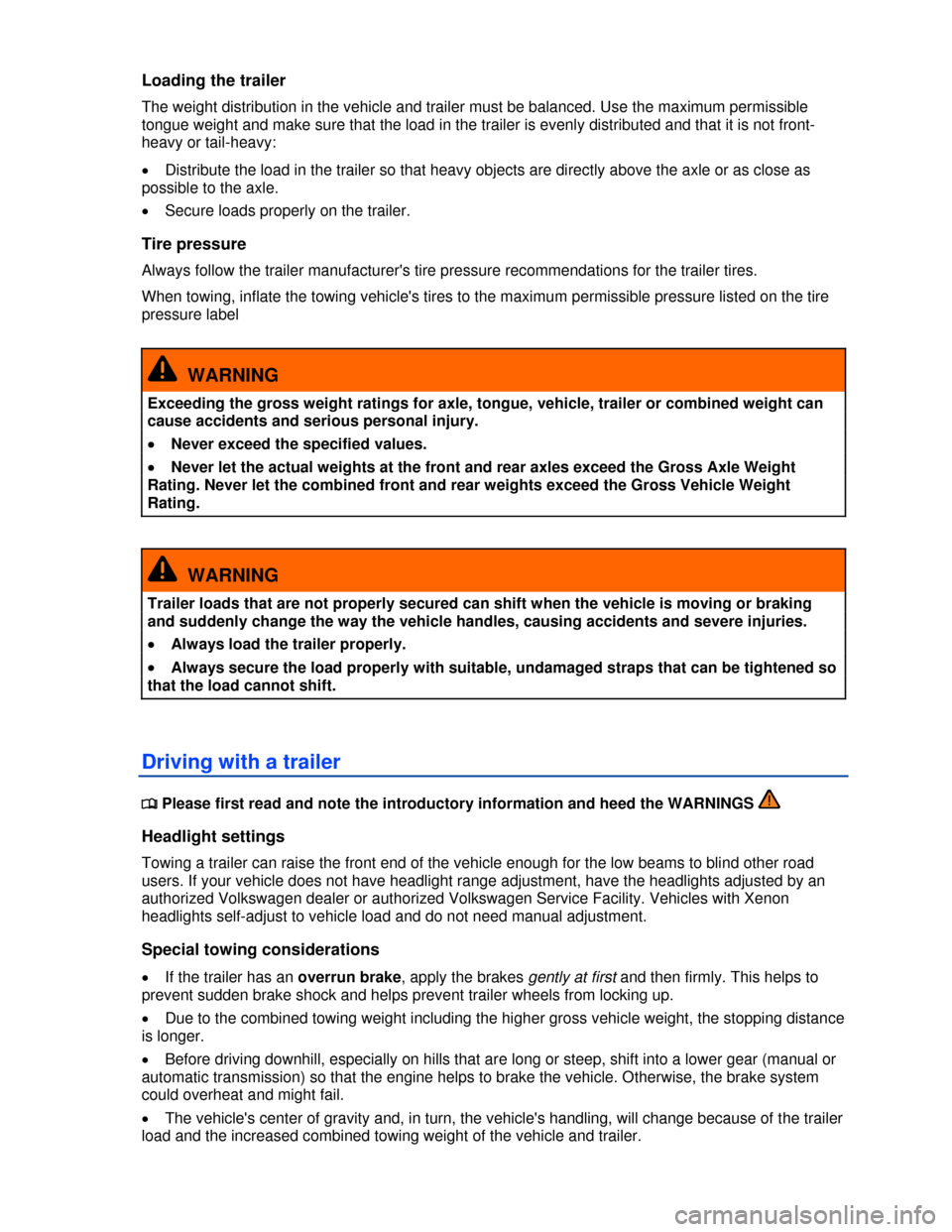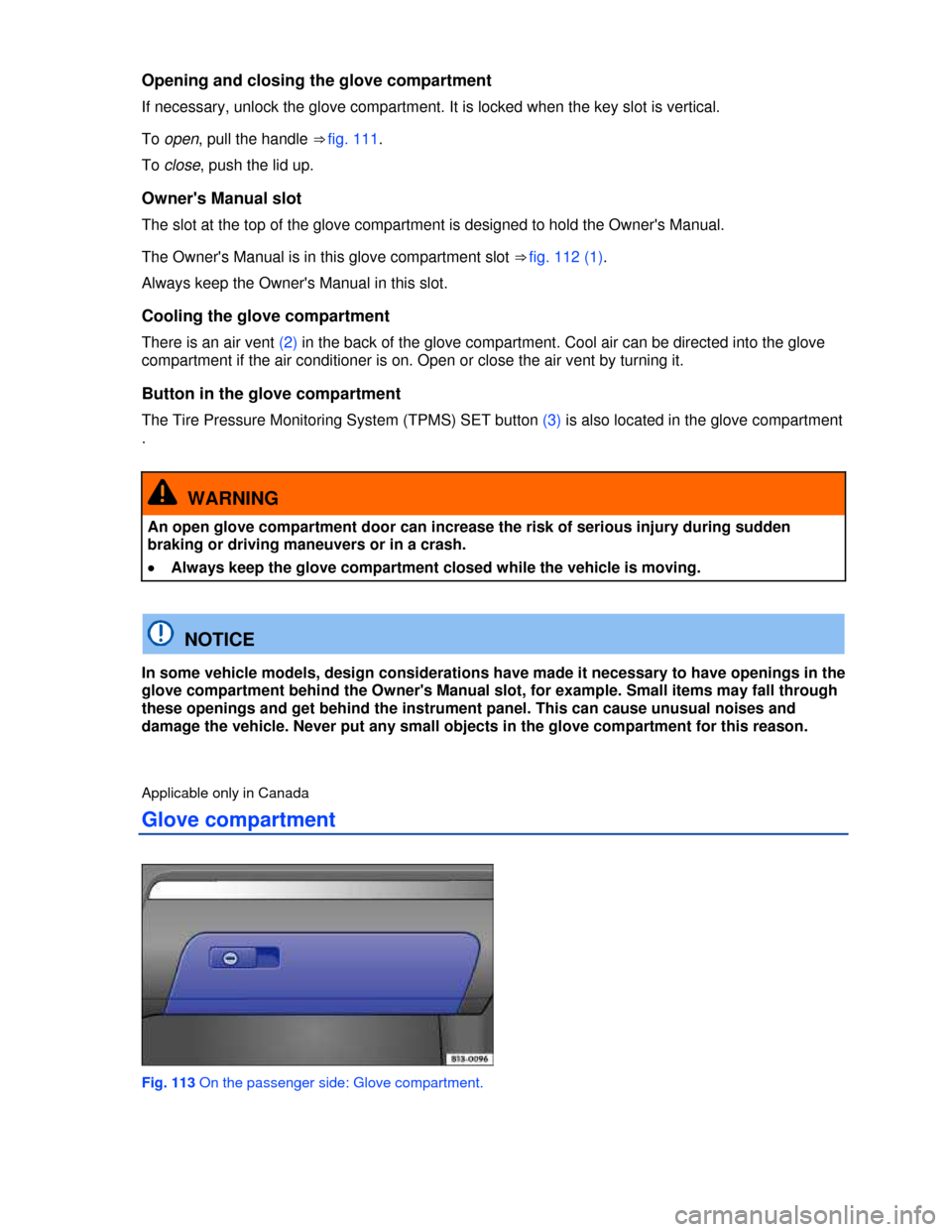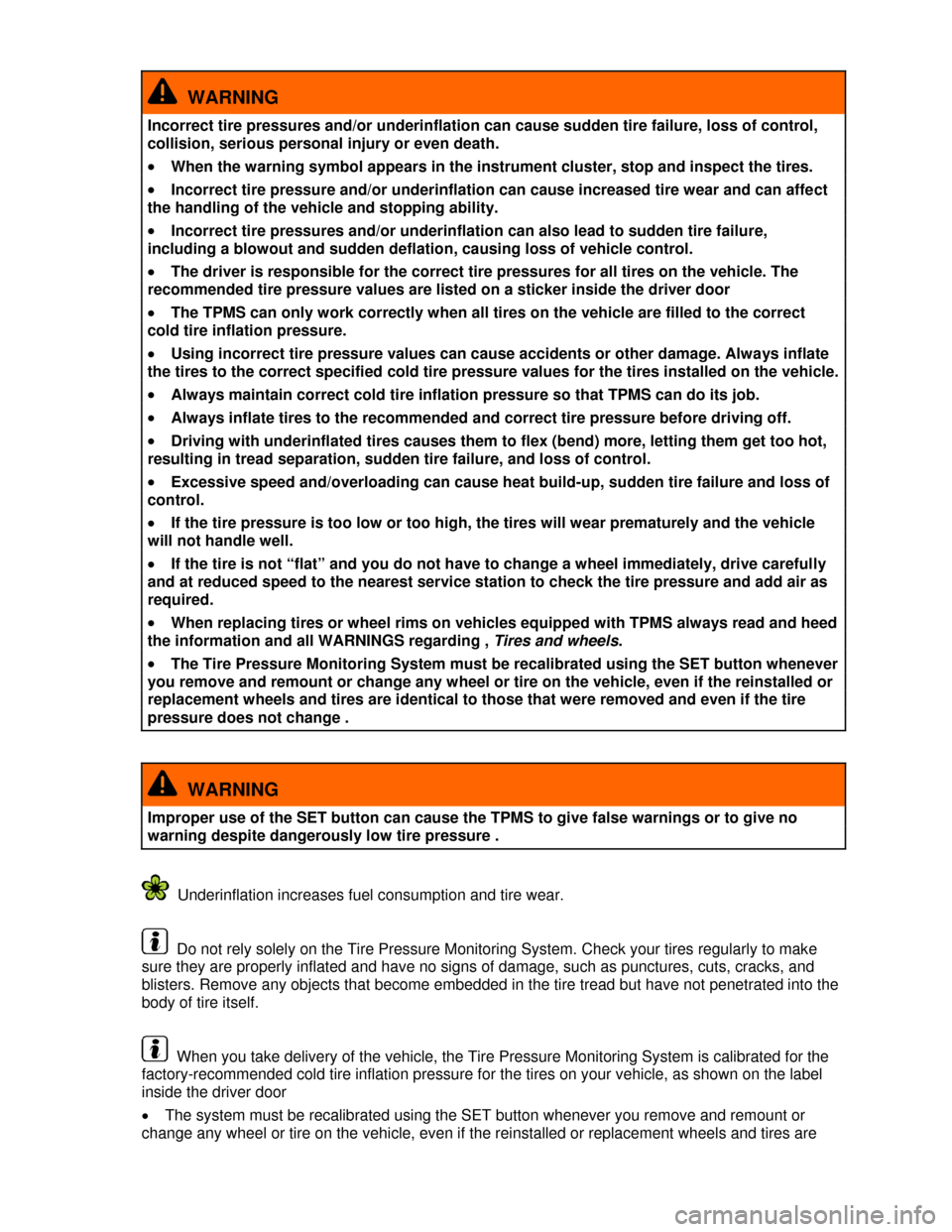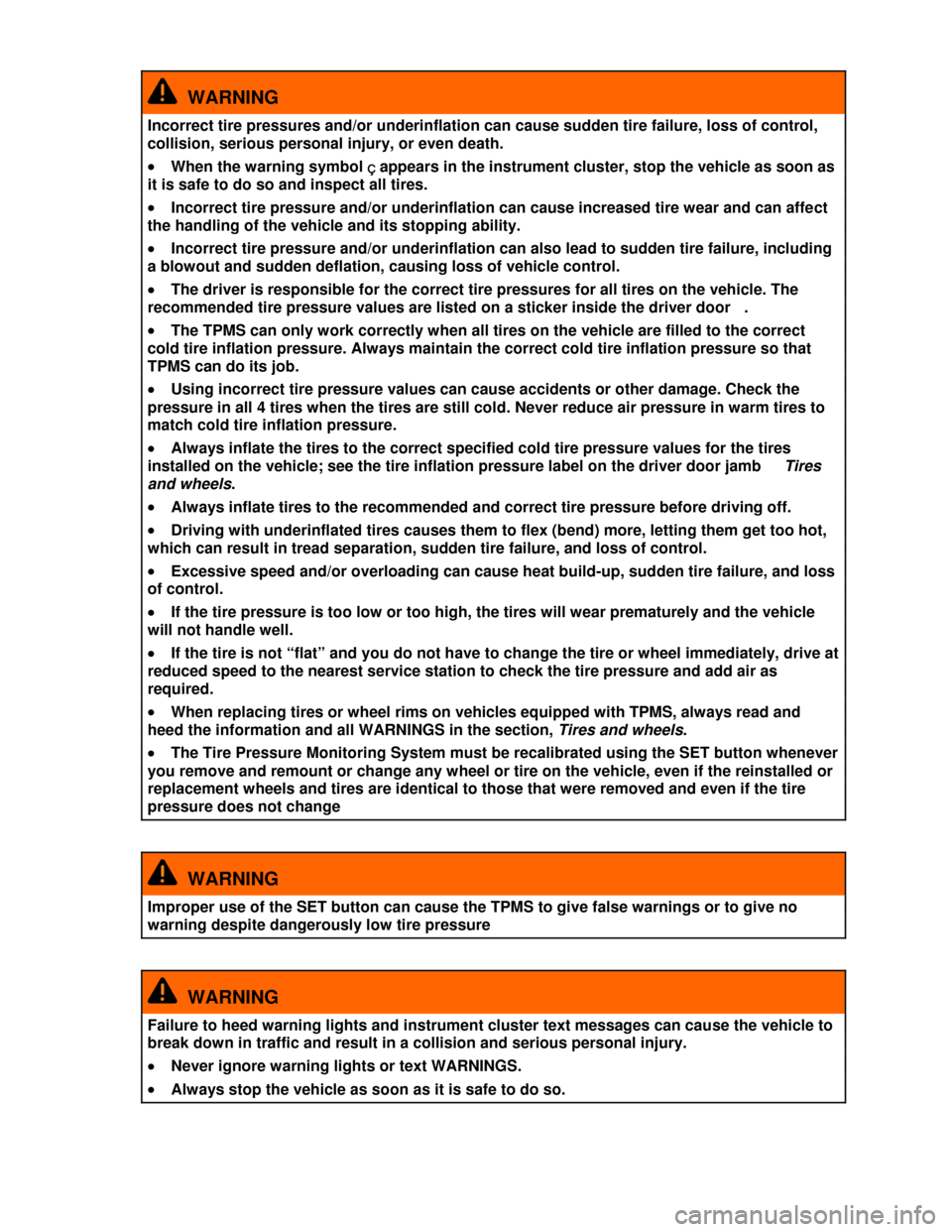2013 VOLKSWAGEN GOLF tire pressure
[x] Cancel search: tire pressurePage 131 of 321

Loading the trailer
The weight distribution in the vehicle and trailer must be balanced. Use the maximum permissible
tongue weight and make sure that the load in the trailer is evenly distributed and that it is not front-
heavy or tail-heavy:
�x Distribute the load in the trailer so that heavy objects are directly above the axle or as close as
possible to the axle.
�x Secure loads properly on the trailer.
Tire pressure
Always follow the trailer manufacturer's tire pressure recommendations for the trailer tires.
When towing, inflate the towing vehicle's tires to the maximum permissible pressure listed on the tire
pressure label
WARNING
Exceeding the gross weight ratings for axle, tongue, vehicle, trailer or combined weight can
cause accidents and serious personal injury.
�x Never exceed the specified values.
�x Never let the actual weights at the front and rear axles exceed the Gross Axle Weight
Rating. Never let the combined front and rear weights exceed the Gross Vehicle Weight
Rating.
WARNING
Trailer loads that are not properly secured can shift when the vehicle is moving or braking
and suddenly change the way the vehicle handles, causing accidents and severe injuries.
�x Always load the trailer properly.
�x Always secure the load properly with suitable, undamaged straps that can be tightened so
that the load cannot shift.
Driving with a trailer
�
Page 142 of 321

Opening and closing the glove compartment
If necessary, unlock the glove compartment. It is locked when the key slot is vertical.
To open, pull the handle ⇒ fig. 111.
To close, push the lid up.
Owner's Manual slot
The slot at the top of the glove compartment is designed to hold the Owner's Manual.
The Owner's Manual is in this glove compartment slot ⇒ fig. 112 (1).
Always keep the Owner's Manual in this slot.
Cooling the glove compartment
There is an air vent (2) in the back of the glove compartment. Cool air can be directed into the glove
compartment if the air conditioner is on. Open or close the air vent by turning it.
Button in the glove compartment
The Tire Pressure Monitoring System (TPMS) SET button (3) is also located in the glove compartment
.
WARNING
An open glove compartment door can increase the risk of serious injury during sudden
braking or driving maneuvers or in a crash.
�x Always keep the glove compartment closed while the vehicle is moving.
NOTICE
In some vehicle models, design considerations have made it necessary to have openings in the
glove compartment behind the Owner's Manual slot, for example. Small items may fall through
these openings and get behind the instrument panel. This can cause unusual noises and
damage the vehicle. Never put any small objects in the glove compartment for this reason.
Applicable only in Canada
Glove compartment
Fig. 113 On the passenger side: Glove compartment.
Page 191 of 321

Adjust the tire pressure
The proper tire pressure helps reduce rolling resistance as well as fuel consumption.
When purchasing new tires, always make sure that the tires are optimized for lower rolling resistance.
Use low viscosity engine oil
Fully “synthetic,” low viscosity engine oils that expressly comply with Volkswagen oil quality standards
reduce fuel consumption. Low viscosity engine oils reduce the frictional resistance on the engine and
are distributed more evenly and quickly, particularly when cold-starting the engine. The effect is
particularly apparent in vehicles that frequently travel short distances.
Always ensure the right engine oil level is maintained and keep to the scheduled service intervals
(engine oil changes).
Make sure the engine oil that you purchase expressly complies with Volkswagen oil quality standards
and is the oil approved by Volkswagen for your vehicle.
Avoid unnecessary weight
The lighter the vehicle, the more economical and eco-friendly it will be. For example, an extra 220 lbs
(100 kg) of weight increases fuel consumption by up to 1 pint per 60 miles (0.3 l/100 km).
Remove all unnecessary items and unnecessary dead weight from the vehicle.
Remove unnecessary aftermarket components
The more aerodynamic the vehicle, the less fuel it will consume. Aftermarket components such as
bicycle racks reduce its aerodynamic performance.
Therefore, remove unnecessary structures and unused rack systems, particularly if planning to drive at
higher speeds.
Page 201 of 321

Tire Pressure Monitoring System (TPMS)
Applicable only in the United States
�
Page 202 of 321

WARNING
Incorrect tire pressures and/or underinflation can cause sudden tire failure, loss of control,
collision, serious personal injury or even death.
�x When the warning symbol appears in the instrument cluster, stop and inspect the tires.
�x Incorrect tire pressure and/or underinflation can cause increased tire wear and can affect
the handling of the vehicle and stopping ability.
�x Incorrect tire pressures and/or underinflation can also lead to sudden tire failure,
including a blowout and sudden deflation, causing loss of vehicle control.
�x The driver is responsible for the correct tire pressures for all tires on the vehicle. The
recommended tire pressure values are listed on a sticker inside the driver door
�x The TPMS can only work correctly when all tires on the vehicle are filled to the correct
cold tire inflation pressure.
�x Using incorrect tire pressure values can cause accidents or other damage. Always inflate
the tires to the correct specified cold tire pressure values for the tires installed on the vehicle.
�x Always maintain correct cold tire inflation pressure so that TPMS can do its job.
�x Always inflate tires to the recommended and correct tire pressure before driving off.
�x Driving with underinflated tires causes them to flex (bend) more, letting them get too hot,
resulting in tread separation, sudden tire failure, and loss of control.
�x Excessive speed and/overloading can cause heat build-up, sudden tire failure and loss of
control.
�x If the tire pressure is too low or too high, the tires will wear prematurely and the vehicle
will not handle well.
�x If the tire is not “flat” and you do not have to change a wheel immediately, drive carefully
and at reduced speed to the nearest service station to check the tire pressure and add air as
required.
�x When replacing tires or wheel rims on vehicles equipped with TPMS always read and heed
the information and all WARNINGS regarding , Tires and wheels.
�x The Tire Pressure Monitoring System must be recalibrated using the SET button whenever
you remove and remount or change any wheel or tire on the vehicle, even if the reinstalled or
replacement wheels and tires are identical to those that were removed and even if the tire
pressure does not change .
WARNING
Improper use of the SET button can cause the TPMS to give false warnings or to give no
warning despite dangerously low tire pressure .
Underinflation increases fuel consumption and tire wear.
Do not rely solely on the Tire Pressure Monitoring System. Check your tires regularly to make
sure they are properly inflated and have no signs of damage, such as punctures, cuts, cracks, and
blisters. Remove any objects that become embedded in the tire tread but have not penetrated into the
body of tire itself.
When you take delivery of the vehicle, the Tire Pressure Monitoring System is calibrated for the
factory-recommended cold tire inflation pressure for the tires on your vehicle, as shown on the label
inside the driver door
�x The system must be recalibrated using the SET button whenever you remove and remount or
change any wheel or tire on the vehicle, even if the reinstalled or replacement wheels and tires are
Page 203 of 321

identical to those that were removed and even if the tire pressure does not change Error!
Bookmark not defined..
�x If you have to adjust the tire pressure on a warm tire, fill the tire with 2.0 - 4.35 psi (20 - 30 kPa)
more than the pressure specified on the tire pressure label inside the driver door 260.
�x If the TPMS determines that the air pressure in at least one tire is too low, carefully check the
pressure in all 4 tires with an accurate tire pressure gauge. Low tire pressure usually cannot be
determined by looking at the tire. This is especially true of low-profile tires.
If you have work done on your wheels or tires, inform the workshop that the vehicle is equipped
with a Tire Pressure Monitoring System (TPMS).
New tires may expand slightly the first time they are driven at high speeds, which can trigger a
tire pressure warning. Remember that tire pressure can only be properly measured when the tire is
“cold” 260.
Only replace old tires with tires that have been approved by Volkswagen for your vehicle type.
Applicable only in the United States
Indicator light (telltale) �
Page 204 of 321

WARNING
Incorrect tire pressures and/or underinflation can cause sudden tire failure, loss of control,
collision, serious personal injury, or even death.
�x When the warning symbol Ç appears in the instrument cluster, stop the vehicle as soon as
it is safe to do so and inspect all tires.
�x Incorrect tire pressure and/or underinflation can cause increased tire wear and can affect
the handling of the vehicle and its stopping ability.
�x Incorrect tire pressure and/or underinflation can also lead to sudden tire failure, including
a blowout and sudden deflation, causing loss of vehicle control.
�x The driver is responsible for the correct tire pressures for all tires on the vehicle. The
recommended tire pressure values are listed on a sticker inside the driver door .
�x The TPMS can only work correctly when all tires on the vehicle are filled to the correct
cold tire inflation pressure. Always maintain the correct cold tire inflation pressure so that
TPMS can do its job.
�x Using incorrect tire pressure values can cause accidents or other damage. Check the
pressure in all 4 tires when the tires are still cold. Never reduce air pressure in warm tires to
match cold tire inflation pressure.
�x Always inflate the tires to the correct specified cold tire pressure values for the tires
installed on the vehicle; see the tire inflation pressure label on the driver door jamb Tires
and wheels.
�x Always inflate tires to the recommended and correct tire pressure before driving off.
�x Driving with underinflated tires causes them to flex (bend) more, letting them get too hot,
which can result in tread separation, sudden tire failure, and loss of control.
�x Excessive speed and/or overloading can cause heat build-up, sudden tire failure, and loss
of control.
�x If the tire pressure is too low or too high, the tires will wear prematurely and the vehicle
will not handle well.
�x If the tire is not “flat” and you do not have to change the tire or wheel immediately, drive at
reduced speed to the nearest service station to check the tire pressure and add air as
required.
�x When replacing tires or wheel rims on vehicles equipped with TPMS, always read and
heed the information and all WARNINGS in the section, Tires and wheels.
�x The Tire Pressure Monitoring System must be recalibrated using the SET button whenever
you remove and remount or change any wheel or tire on the vehicle, even if the reinstalled or
replacement wheels and tires are identical to those that were removed and even if the tire
pressure does not change
WARNING
Improper use of the SET button can cause the TPMS to give false warnings or to give no
warning despite dangerously low tire pressure
WARNING
Failure to heed warning lights and instrument cluster text messages can cause the vehicle to
break down in traffic and result in a collision and serious personal injury.
�x Never ignore warning lights or text WARNINGS.
�x Always stop the vehicle as soon as it is safe to do so.
Page 205 of 321

NOTICE
Failure to heed warning lights or text WARNINGS can result in vehicle damage.
If the ignition is switched on, an acoustic warning sounds when low tire pressure is detected. If a
system malfunction is detected, no acoustic warning sounds.
Driving for a longer period of time on rough roads or with a dynamic and sporty style can make
the TPMS system temporarily unavailable. The indicator light will come on, signaling a malfunction, but
will go out again once the road condition or driving style changes.